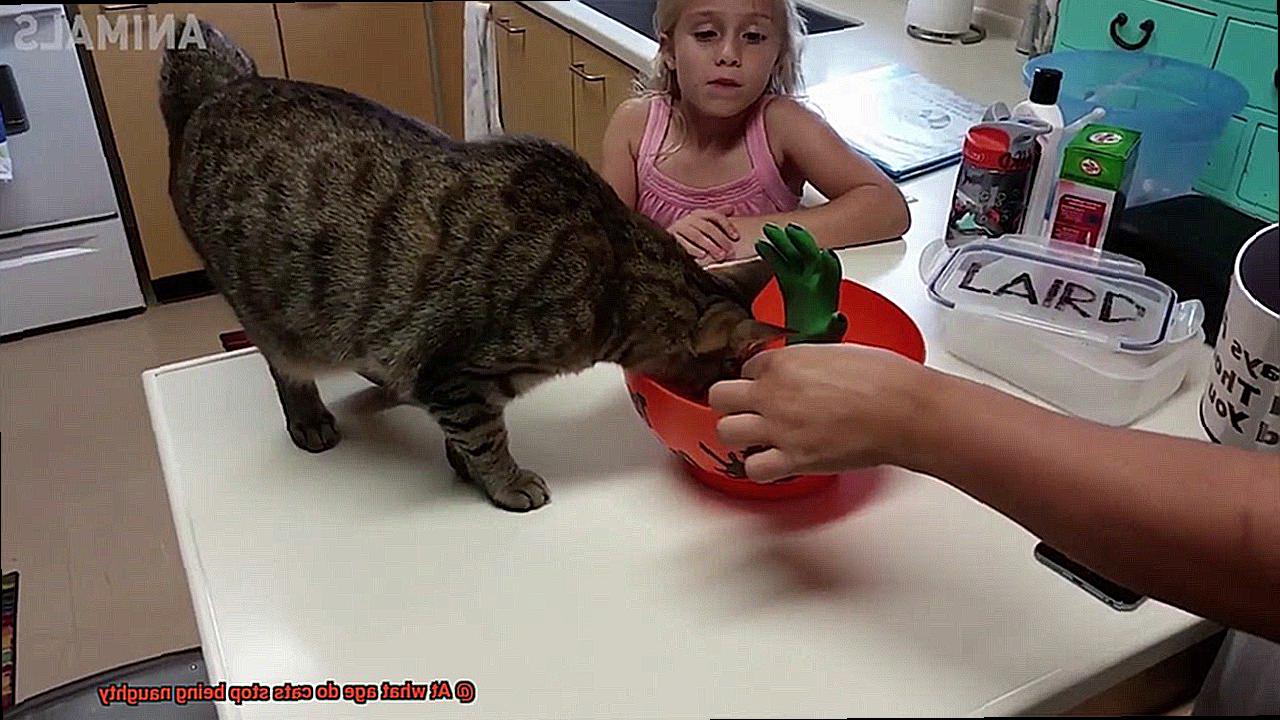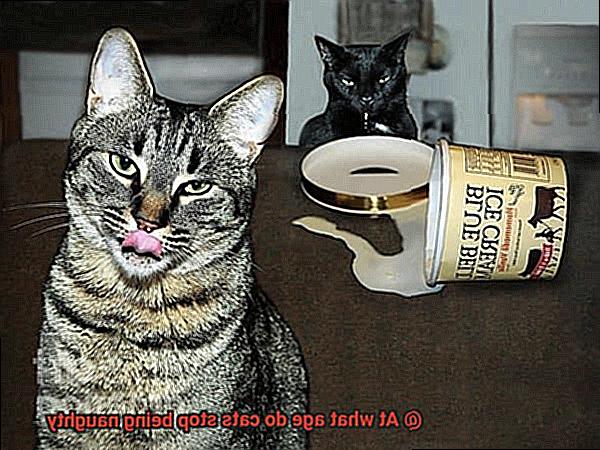Do you find yourself constantly chasing after your cat, trying to stop them from wreaking havoc in your home? From scratching your furniture to knocking over ornaments, cats can be quite the handful. But have you ever wondered at what age do cats stop being naughty?
As an expert on feline behavior, I’ve spent countless hours studying and observing cats of all ages. And while it’s safe to say that cats never really lose their mischievous streak, their behavior does evolve as they age.
In this blog post, we’ll explore the different stages of a cat’s life and how their behavior changes over time. From the adorable kitten stage where they’re learning about the world around them and pushing boundaries to the more independent and self-assured adult stage, we’ll delve into all the antics our furry friends get up to.
But it’s not just age that affects a cat’s behavior. Factors such as breed, socialization, and environment can also play a significant role in shaping their personalities. By understanding these factors and how they influence your cat’s behavior, you can help them grow into well-behaved and happy adult cats.
So if you’re tired of constantly scolding your feline friend for their naughty ways or simply curious about what makes them tick, then join me as we uncover at what age do cats stop being naughty.

General Patterns of Cat Behavior
Cats are endlessly fascinating creatures that never cease to amaze and entertain us with their playful and curious behavior. But as cat owners, we may wonder when our feline companions will grow out of their mischievous ways and become mature adults. While there is no magic age at which cats stop being naughty, there are some general patterns of behavior that can be observed throughout a cat’s life.
Kittens are the epitome of playful energy, and their natural curiosity often leads them to engage in what humans may consider naughty behavior. From climbing curtains to scratching furniture, kittens are simply exploring their surroundings and learning about the world around them.
As they enter their adolescent years, some of this behavior may continue, but as cats mature into adulthood, their behavior tends to become more relaxed and less energetic.
Of course, even adult cats may still display some naughty behavior from time to time. This could be due to boredom, stress, or simply a desire to play. As responsible cat owners, we must provide our feline friends with plenty of toys and stimulation to help prevent destructive behavior.

As cats enter their senior years, they may become less active overall, but they still require mental stimulation and exercise to keep them healthy and happy. Some older cats may even become more vocal or demanding attention as they age, displaying what some may consider naughty behavior.
Age-Related Changes in Cat Behavior

As your beloved cat ages, it’s normal to notice changes in their behavior. However, these changes don’t mean that your feline friend will stop being “naughty.” In fact, some senior cats may even become more mischievous as they age. So, what are the most common age-related changes in cat behavior?
One of the most common changes is a decrease in activity level. As cats grow older, they tend to sleep more and play less. This could be due to decreased mobility or joint pain, but not all senior cats experience this change. Some may remain just as active as they were in their youth. It’s important to provide appropriate toys and activities to keep them stimulated and prevent boredom.
Another change is an increase in territoriality. Senior cats may become more set in their ways and less tolerant of changes in their environment. This can lead to increased aggression towards other pets or people who enter their territory. Providing a safe and comfortable environment for your furry friend is crucial during this time.
Furthermore, older cats may become more vocal and demanding of attention due to cognitive decline or physical discomfort. Giving them plenty of mental and physical stimulation can help combat these changes in behavior. Playing with them regularly or providing puzzle toys can help keep their minds sharp.
It’s important to understand that age-related changes in cat behavior are normal, but they can also be accommodated to ensure your senior cat remains happy and healthy. By providing a stimulating environment with plenty of toys and activities, you can prevent destructive behavior caused by boredom or stress. Regular vet check-ups can also help detect any underlying health issues.
Maine Coon Cats and the Long Kittenhood
Maine Coon cats are not your average feline. These charming creatures are known for their large size, fluffy coats, and delightful personalities. But did you know that they also have a prolonged kittenhood compared to other cat breeds?
Maine Coon cats can take up to five years to reach full maturity, making them one of the slowest cats to mature. During this extended kittenhood, they tend to be more active and playful than other breeds. Their mischievous behavior can sometimes be interpreted as “naughty” by their owners, but it’s all part of their natural development.
As Maine Coon cats grow older, they become less hyperactive and more relaxed. They start to develop a more independent personality, which means they may not need as much attention as they did during their kittenhood. However, this doesn’t mean they stop being playful altogether. Even as adults, Maine Coon cats remain curious and love to play with toys and interact with their owners.
It’s crucial to remember that each cat has a unique personality, and their behavior can vary depending on their environment and upbringing. While some Maine Coon cats may calm down as early as two years old, others may take longer to mature fully. Understanding your cat’s individual needs is the key to ensuring a happy and healthy relationship with your Maine Coon cat.
So, how can you make sure your Maine Coon cat is living their best life? Providing them with a stimulating environment filled with toys and activities that cater to their playful nature is an excellent start. Regular vet check-ups are also essential to ensure they remain healthy throughout their extended kittenhood.
Adult Cats May Still Display Naughty Behaviors
As much as we love our feline friends, we cannot deny that cats can sometimes exhibit naughty behaviors. And contrary to popular belief, these behaviors do not necessarily disappear as they grow older. In fact, adult cats may still display naughty behaviors that can be frustrating for their owners.
One of the most common naughty behaviors that adult cats exhibit is scratching furniture or other household items. This behavior is not only destructive but can also be dangerous, especially when they scratch electrical cords or other hazardous materials. However, it’s important to understand that scratching is a natural behavior for cats. Providing your cat with appropriate scratching posts and discouraging them from scratching inappropriate items can help redirect this behavior and save your furniture.
Another naughty behavior that adult cats may exhibit is aggression towards people or other animals. This can be a result of various factors such as fear or territoriality. Aggressive behavior in cats can be scary and dangerous, so it’s important to address this behavior early on before it escalates into something more serious. Consulting with a veterinarian or animal behaviorist can help identify the underlying cause and provide appropriate solutions to prevent any harm.
In addition, adult cats may still display litter box issues such as not using the litter box or urinating outside of it. This can be caused by medical issues or behavioral problems like stress or anxiety. It is important to take your cat to the veterinarian to rule out any medical issues and provide a clean and comfortable litter box environment for your cat.
Preventing Destructive Behaviors
Firstly, it’s important to understand that cats are naturally curious and playful animals. Destructive behavior is often a result of boredom, anxiety, or frustration. By providing your cat with ample opportunities for play and exercise, you can prevent them from engaging in destructive behaviors.
One effective way to do this is by providing suitable toys and scratching posts. Scratching is a natural behavior for cats, but if they don’t have an appropriate outlet, they may turn to your furniture instead. A dedicated scratching post and interactive toys such as puzzles or balls can redirect their energy and prevent destructive behavior.
Another essential step is establishing a routine for your cat. Cats thrive on consistency, so feeding them at the same time every day and providing regular playtime can reduce anxiety and boredom, which often lead to destructive behavior.
Positive reinforcement training is also an effective way to teach your cat what is acceptable behavior and what is not. With gentle redirection and rewards when they use their scratching post instead of furniture, they will learn good habits quickly.
Remember that some destructive behaviors may be related to underlying medical issues. If you notice any sudden changes in your cat’s behavior, consult with your veterinarian to rule out any medical problems.
dklFk71eZNQ” >
Conclusion
In conclusion, determining the exact age at which cats stop being naughty is not straightforward. However, as cats grow older, their behavior changes along with their physical and mental development. Kittens are known to be naturally curious and playful, which can sometimes lead to what humans perceive as naughty behavior.
As cats mature into adulthood, they tend to become less energetic and more relaxed. But this doesn’t mean that they will never engage in any mischievous activities. Adult cats may still display some naughty behavior from time to time due to boredom, stress, or a desire to play.
Several factors such as breed, socialization, and environment also influence a cat’s personality and behavior. For instance, Maine Coon cats have an extended kittenhood compared to other breeds and tend to be more active and playful during this time. As responsible cat owners, it’s crucial to understand each cat’s unique needs to ensure a happy and healthy relationship.
While preventing destructive behaviors in cats is possible with simple steps like providing suitable toys and scratching posts, establishing routines, and positive reinforcement training; some destructive behaviors may indicate underlying medical issues.
Providing our feline friends with plenty of toys and stimulation while understanding their personalities is key to preventing destructive behavior.

